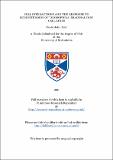Files in this item
Cell interactions and the response to ecolysteroids of 'Drosophila' imaginal disc cell lines
Item metadata
| dc.contributor.advisor | Milner, Martin | |
| dc.contributor.author | Peel, David John | |
| dc.coverage.spatial | 214 p. | en_US |
| dc.date.accessioned | 2018-06-14T13:18:28Z | |
| dc.date.available | 2018-06-14T13:18:28Z | |
| dc.date.issued | 1991 | |
| dc.identifier.uri | https://hdl.handle.net/10023/14068 | |
| dc.description.abstract | This thesis is a study of the biology of Drosophila imaginal disc cells growing as continuous cell lines. Their morphological characteristics and cellular properties were analysed in order to characterise the cells in vitro. Morphological analysis of the cells revealed several cell types within the original cell lines perhaps representing a diversity in the cellular origin of these cells. A new cloning technique was devised which enabled a single imaginal disc cell to give rise to new cell line and indicated that a single cell could give rise to the different cell types seen in culture. This indicates that the diversity in morphology of the cells in culture was an indication of the conditions in culture rather than as a result of cellular diversity. The original cell lines and the newly derived cloned cell lines were subjected to the insect moulting hormone 20-HE in order to ascertain the degree of differentiation that was possible in culture. The cells showed a dramatic morphological response to hormone, they elongated, began to aggregate and threw out cell processes. This is combined with concomitant biochemical changes in the cell lines, including the induction of chitin synthesis and acetylcholinesterase. The cells in culture show a characteristic pattern of aggregation which was studied at the ultrastructural level using electron microscopy. These studies and also immunofluorescence of cell aggregates indicated the prevalence of cell processes and a role was postulated for their action in bringing about these aggregates. Aggregation was also correlated with the expression of PS integrins, which are well characterised Drosophila adhesion molecules. The adhesive properties of the cells were further characterised with reaggregation experiments in different media as a prelude to setting up cell sorting assays between wing and leg cell lines. This proved somewhat inconclusive but pointed to some sorting out occurring between wing and leg cells. | en_US |
| dc.language.iso | en | en_US |
| dc.publisher | University of St Andrews | |
| dc.subject.lcc | QH607.I6P3 | en |
| dc.subject.lcsh | Cell differentiation | en |
| dc.title | Cell interactions and the response to ecolysteroids of 'Drosophila' imaginal disc cell lines | en_US |
| dc.type | Thesis | en_US |
| dc.type.qualificationlevel | Doctoral | en_US |
| dc.type.qualificationname | PhD Doctor of Philosophy | en_US |
| dc.publisher.institution | The University of St Andrews | en_US |
This item appears in the following Collection(s)
Items in the St Andrews Research Repository are protected by copyright, with all rights reserved, unless otherwise indicated.

